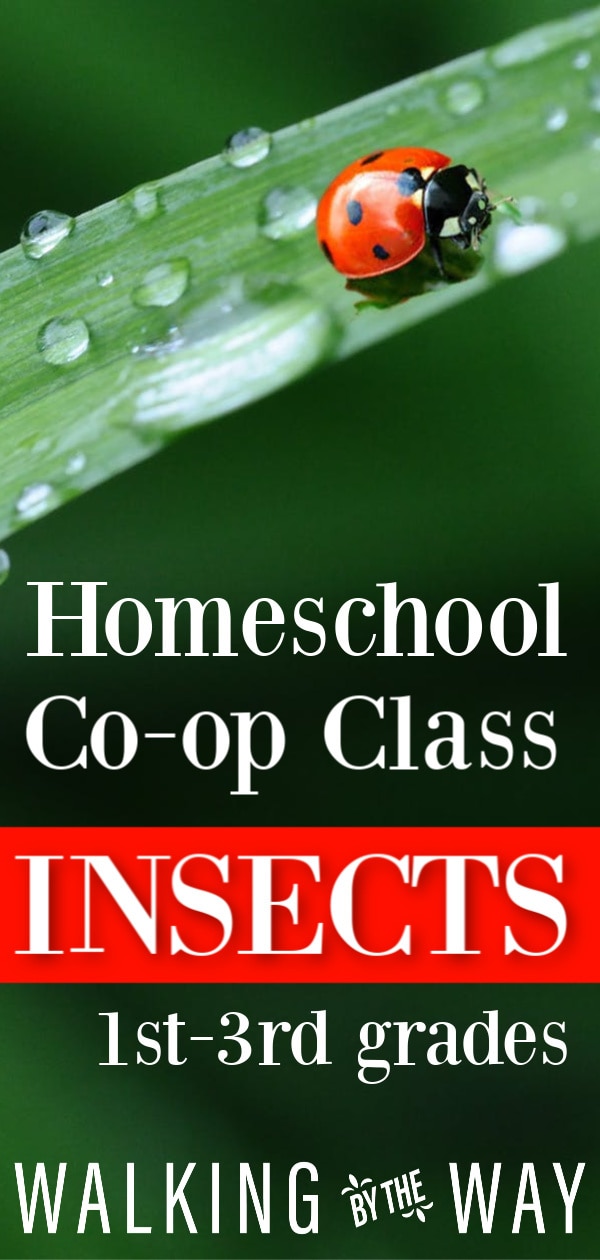Summer is coming, and so are the BUGS!
A few years ago, my friend, Jodi taught two insect classes at co-op. I’ve asked her to guest post about the class.
Most children are fascinated by insects, and this would make a fun class or club for this summer or fall.
For our Fall semester 2012, I taught a co-op class about insects to 13 children (K-3rd grade). We studied a different insect for each of the nine weeks we were in session.
I used Janice VanCleave’s books Insects and Spiders and Play and Find Out About Bugs: Easy Experiments for Young Children for many of the educational activities we did.
Each week we read at least one book about the insect for that week. It’s a good idea to grab extra books from your library about each insect in case you have time leftover at the end of class.
Many of the books we read were Eric Carle books:
- The Very Lonely Firefly
- The Very Hungry Caterpillar
- The Grouchy Ladybug
- The Very Busy Spider (The final week of the class we discussed spiders and why they are NOT insects)
We also used Judy Allen’s engaging Backyard Books to learn true facts about each insect.
At the beginning of each class, the students had an opportunity to Show and Tell of any insects they had caught that week at home.
You can download the syllabus by clicking on the image below.
Week One: Introduction
The first week we determined how to identify an insect.
We did a craft using egg cartons to label the three parts of an insect and sang the song “Head, Thorax, Abdomen” to the tune of “Head, Shoulders, Knees and Toes” to help the kids remember those 3 parts.
Head, thorax, abdomen, abdomen
Head, thorax, abdomen, abdomen
Compound eyes, two antennae and some wings
Head, thorax, abdomen, abdomen.
I purchased compound eye lenses from Oriental Trading Company for the kids to take home along with a magnified bug catcher for each child to catch bugs in throughout the semester.
Here are examples of some of the fun paper and food crafts we created for each insect:
Week Two: Fireflies
For fireflies, we made a firefly body from construction paper and used yellow tissue paper for the abdomen, then taped a cheap flashlight I got from Oriental Trading to the back. Craft Link
We also made a snack with round crackers, cream cheese and slices of kiwi to resemble a firefly.
Week Three: Butterflies
For butterflies, we colored a paper butterfly and glued it to a popsicle stick. Then we rolled in the wings and inserted it into a toilet paper tube colored to look like a chrysalis.
We also made a life cycle of the butterfly on a paper plate and used beans for the eggs, rotini for the caterpillar, shell macaroni for the chrysalis and bow tie macaroni for the butterfly.
Week Four: Grasshoppers and Crickets
We made crickets using black combs and pipe cleaners. Craft Link
We also learned more about vibrations and sounds.
Week Five: Dragonflies
We made cute little dragonflies by painting and gluing plastic spoons and knives. We also added some “compound” eyes.
Week Six: Ants
During our ant week, we made a paper example of what an ant tunnel would look like with 5 rooms: nursery, food room, trash area, Queen, and eggs. We included tunnels leading to each room.
After we read the book, Hey Little Ant by Phillip M. Hoose, we determined what the boys should do with the ant.
Week Seven: Bees
We used paper plates to make bees with wax paper wings. I pre-painted all the paper plates to save time and mess in class.
When we studied bees, we did a demonstration to show how pollination works. I gave all the kids paper lunch bags with flowers glued to the front for them to color. I also gave them paper bees that had two holes at the bottom for their fingers that they colored.
When they were done, we put Cheetos in their bags, asked them to put their bees on their hands and eat the “pollen”. Then they “flew” to their neighbors flower and landed there. The cheese from the Cheetos remained on their friend’s flower.
Week Eight: Ladybugs
We made another paper plate craft when we learned about ladybugs.
We learned about symmetry when we studied both the butterfly and the ladybug.
We talked about how our bodies are also symmetrical–one eye and ear on each side of our face, one arm and leg on each side of our body. We also discussed which shapes are symmetrical–circles, squares, some triangles (only if you split them a certain way), etc.
Week Nine: Spiders
The last class, we talked about why spiders are not insects–only two body parts and eight legs instead of six.
I used painter’s tape to make a web on the floor and we put plastic bugs on the web. The kids walked on the tape to pick up five insects that were trapped in the web.
We also made a web in a doorway with the sticky side facing the kids and they used cotton balls to throw at the web to see if they could get them to stick.
If you have questions for Jodi, please leave them in the comments, and I will make sure she gets them.
Next week, Jodi will share her plans for the upper elementary class she taught. Thanks again, Jodi!















Under the grasshopper and crickets there is a picture of a young boy with a craft. What is the craft called or do you have a link to it. I am sure it is because you spoke of learning about sounds and vibrations. I would like some more information if you have it.
Hi! This looks so fun! Quick question, the link for the syllabus isn’t working. Can you share it again?